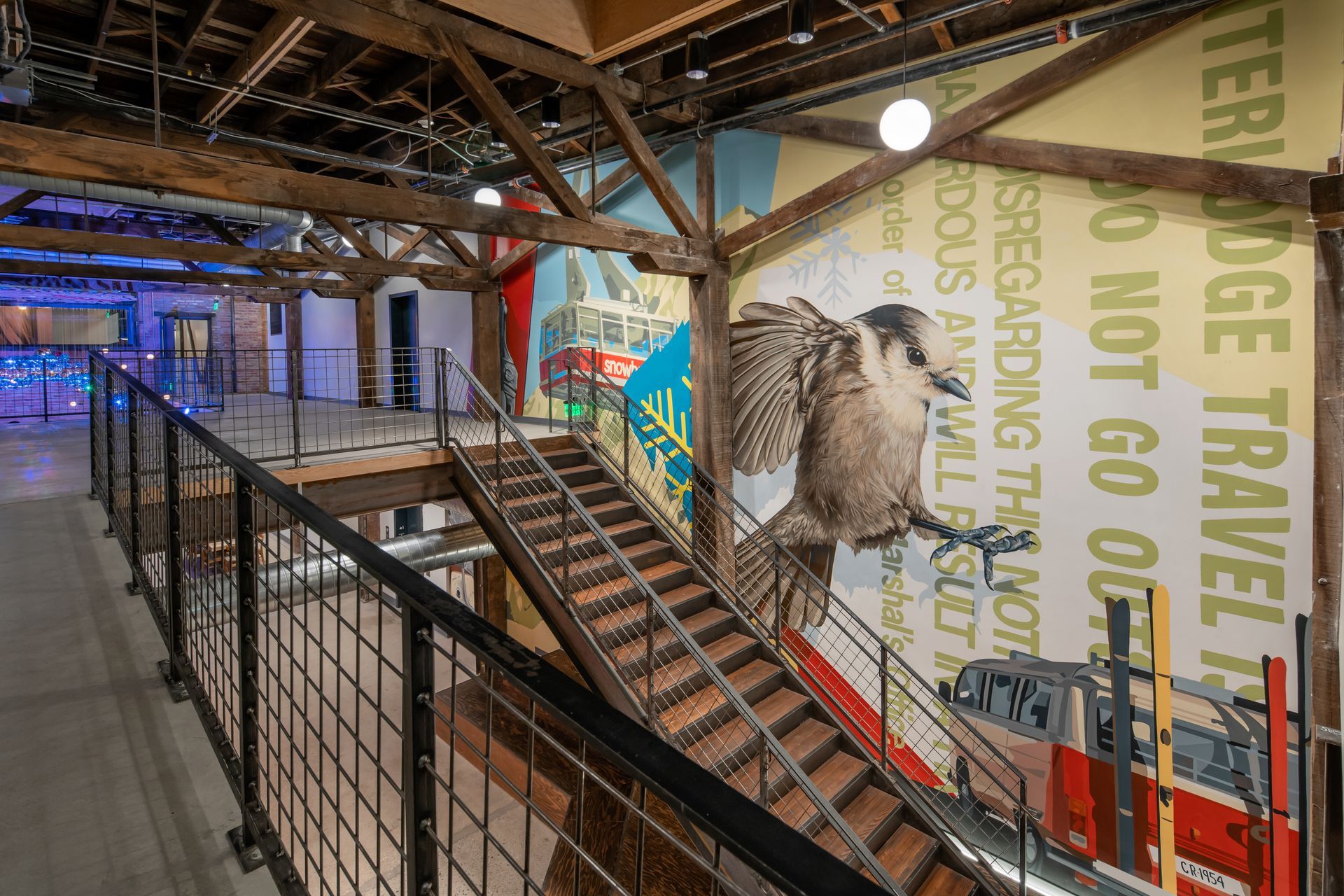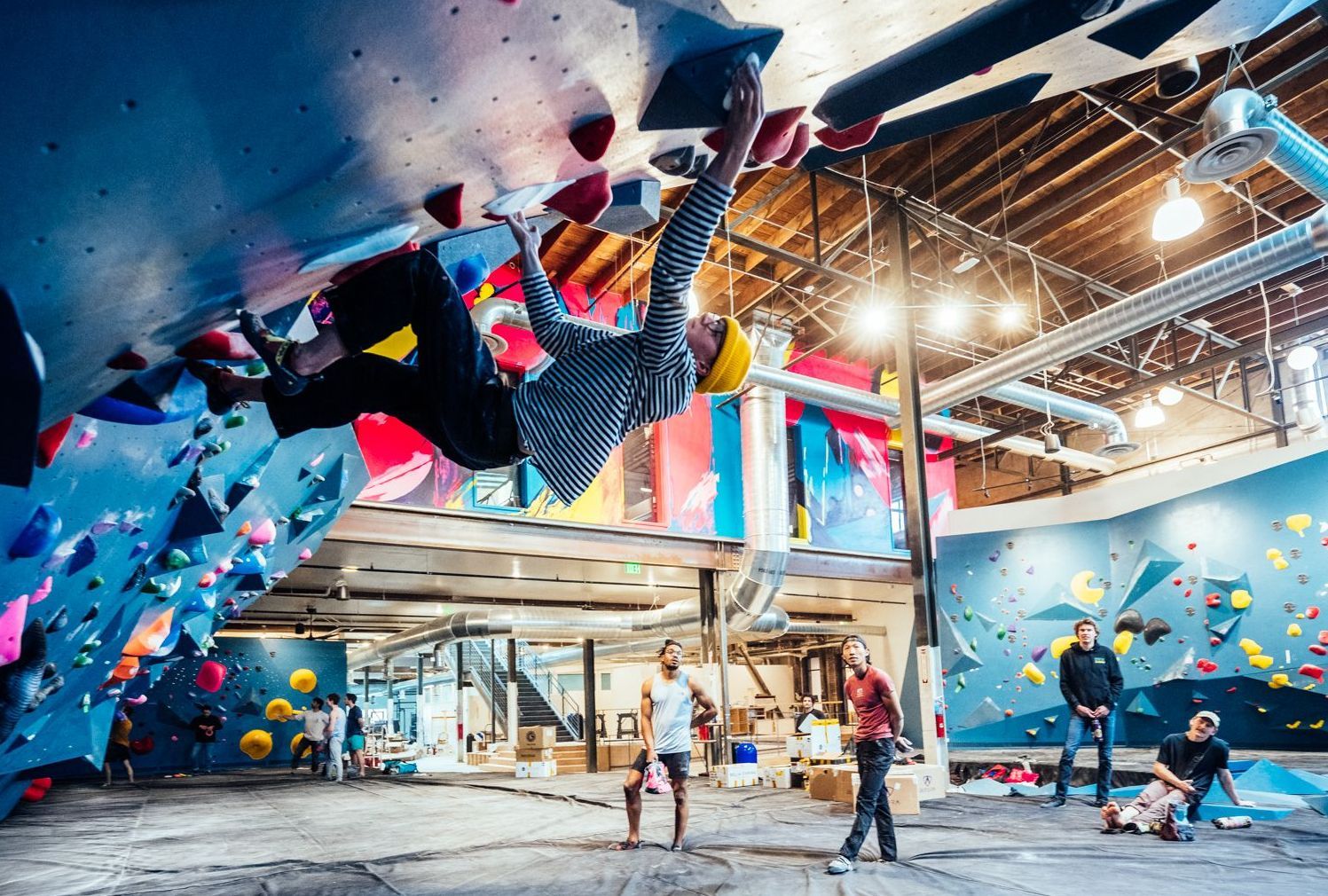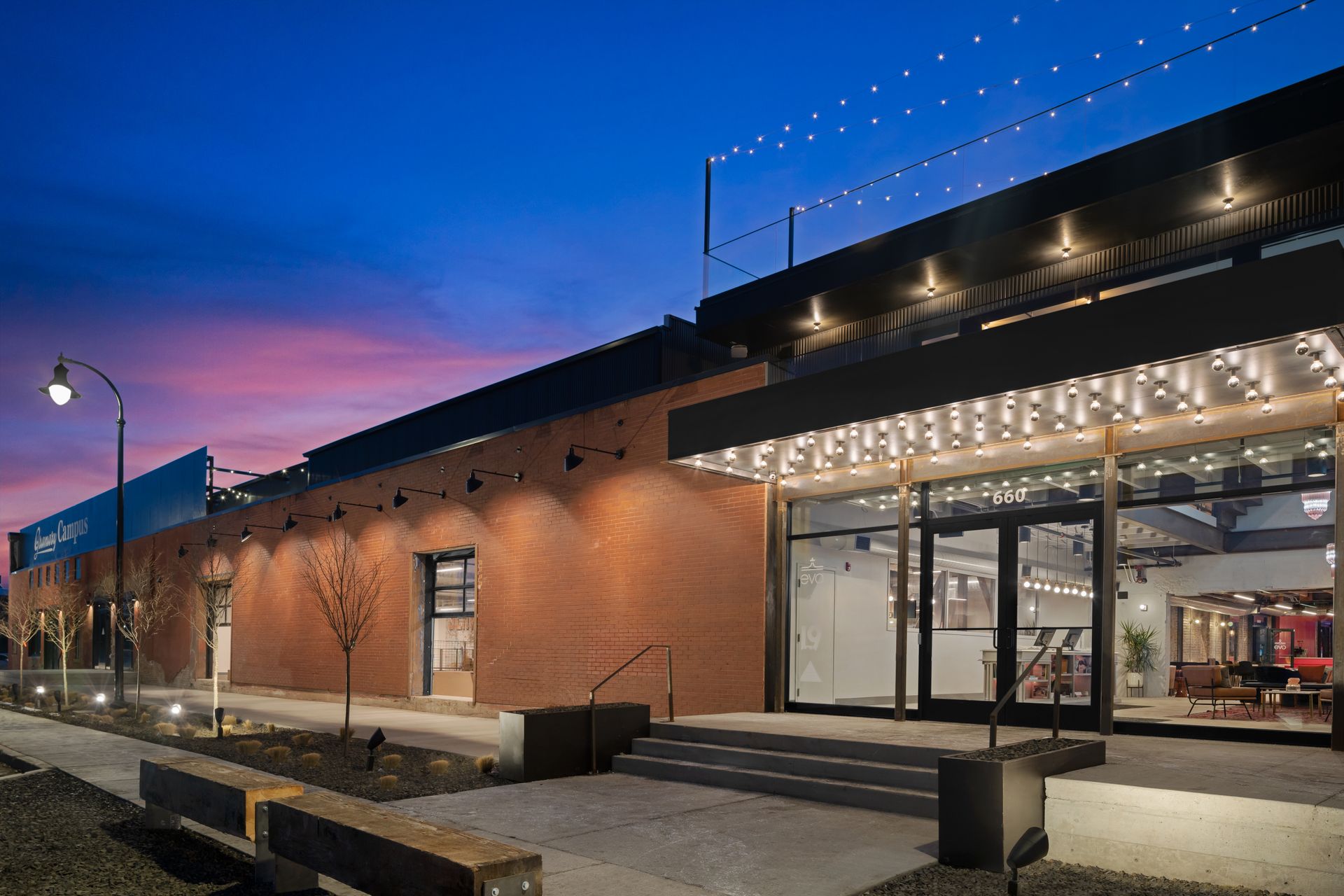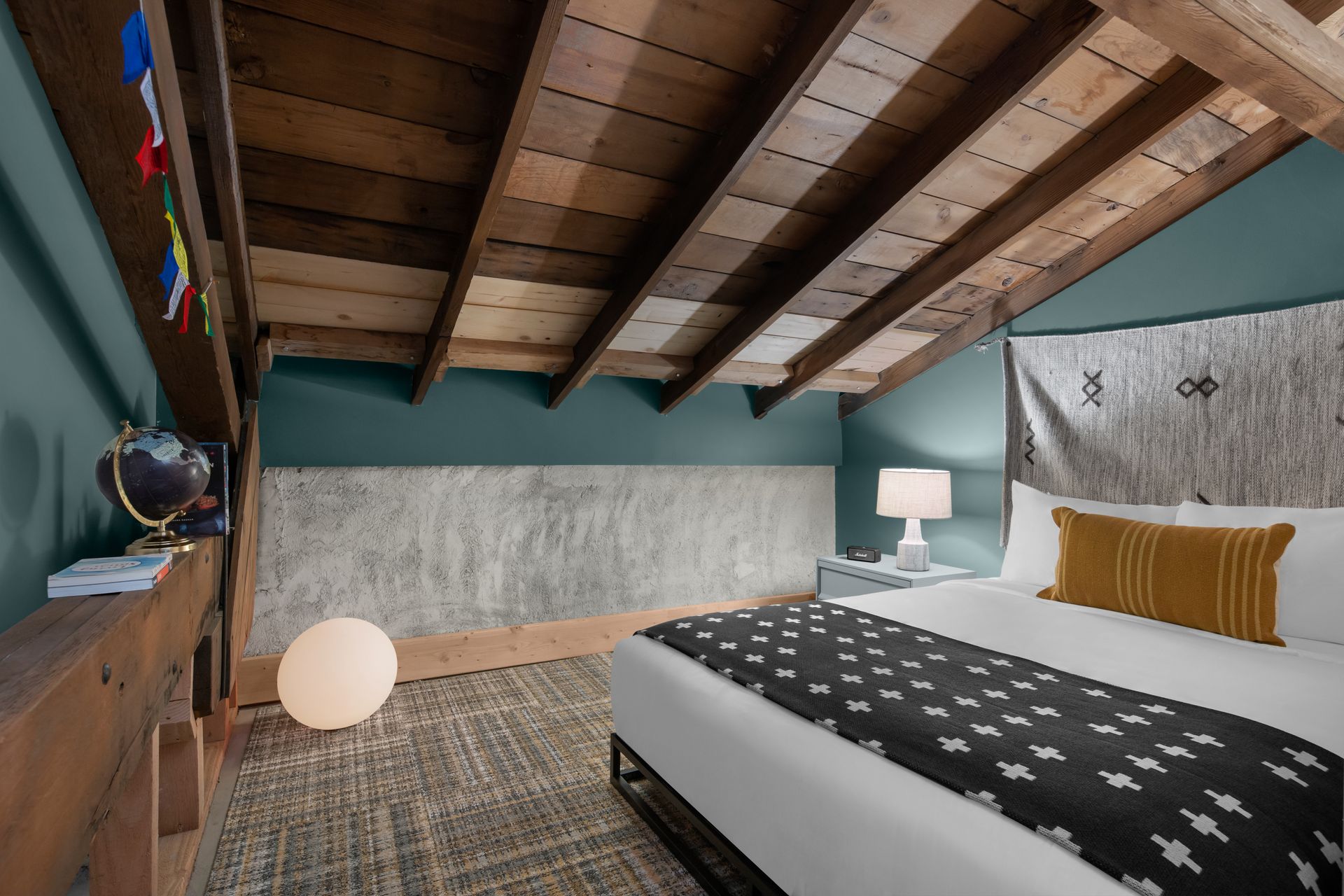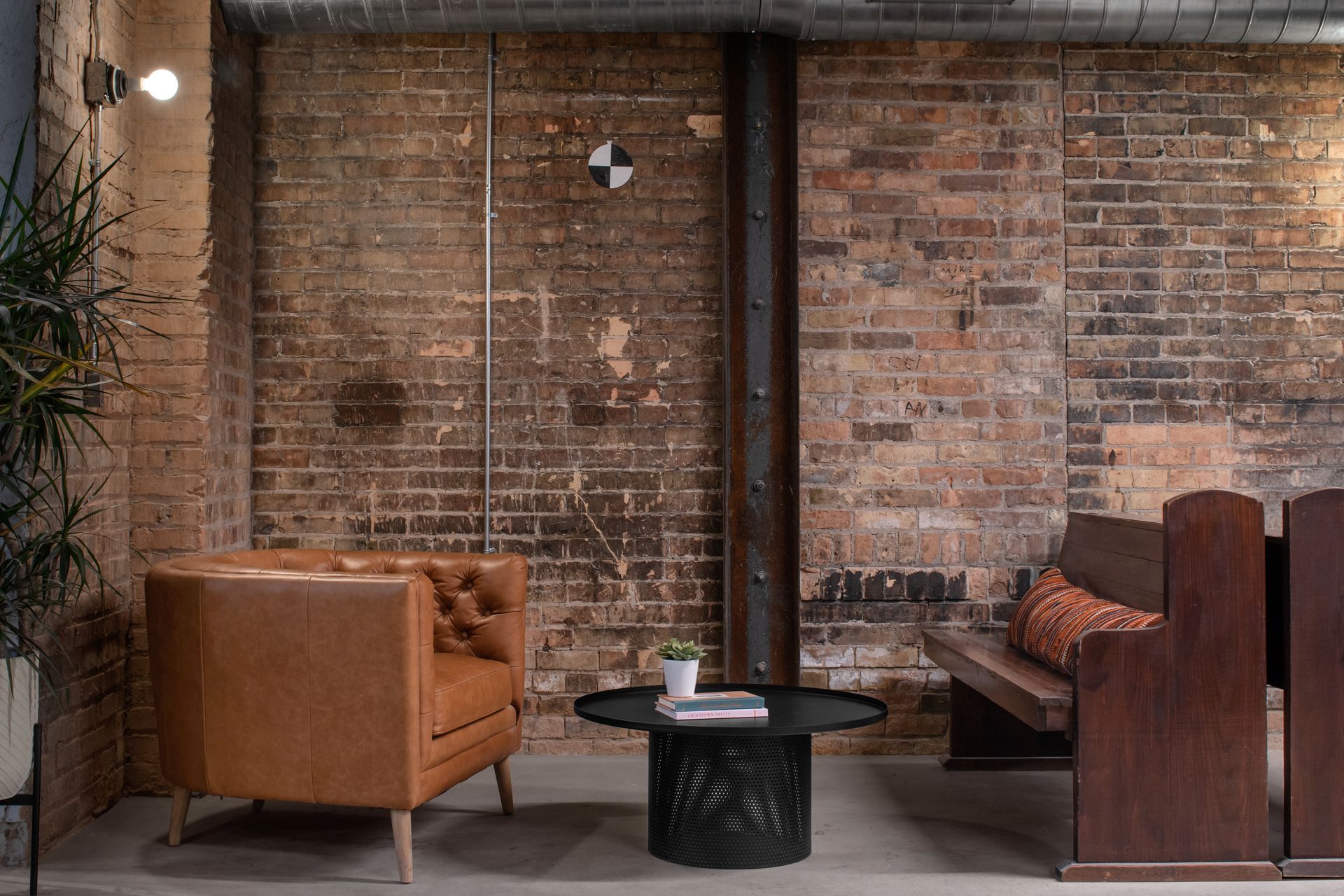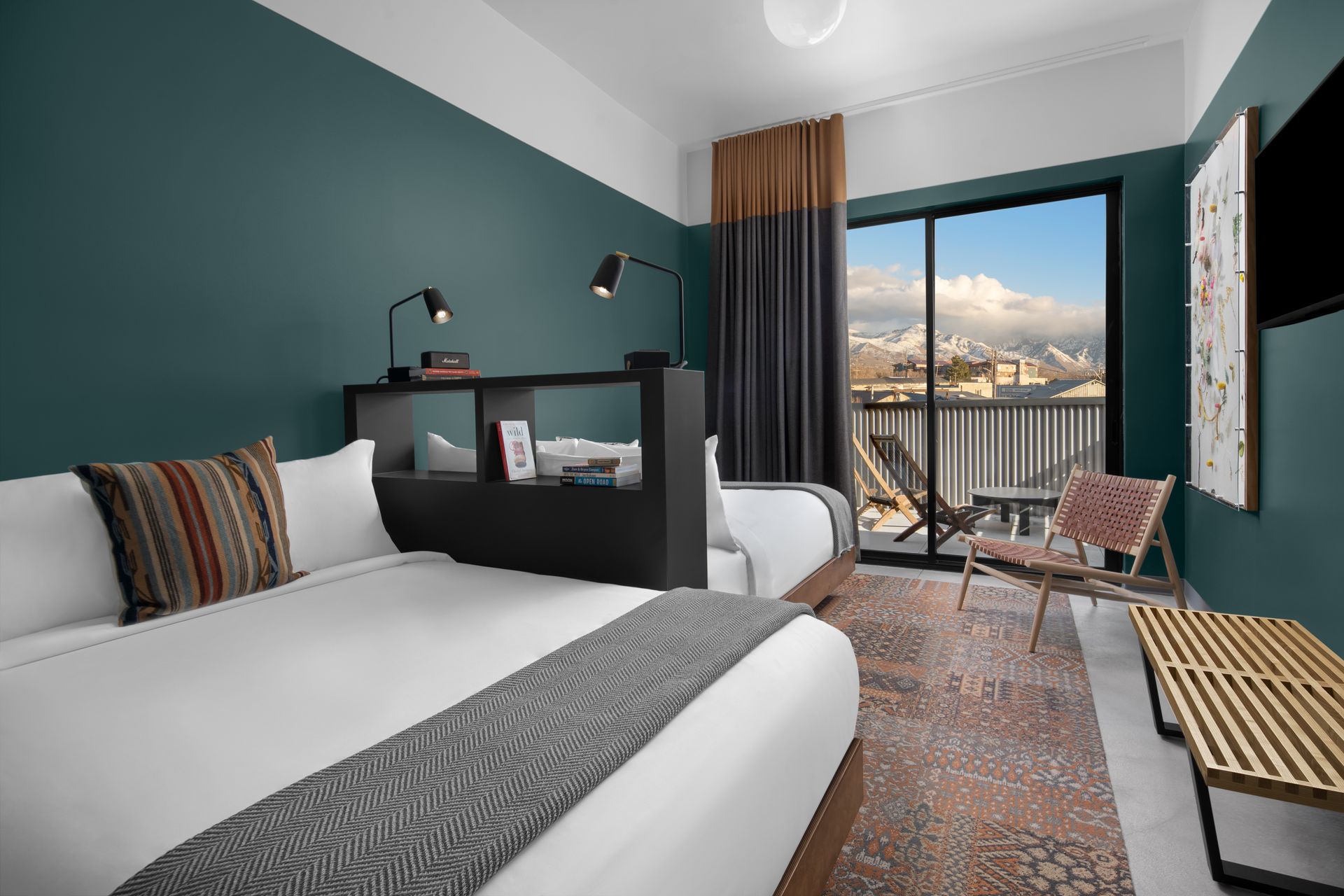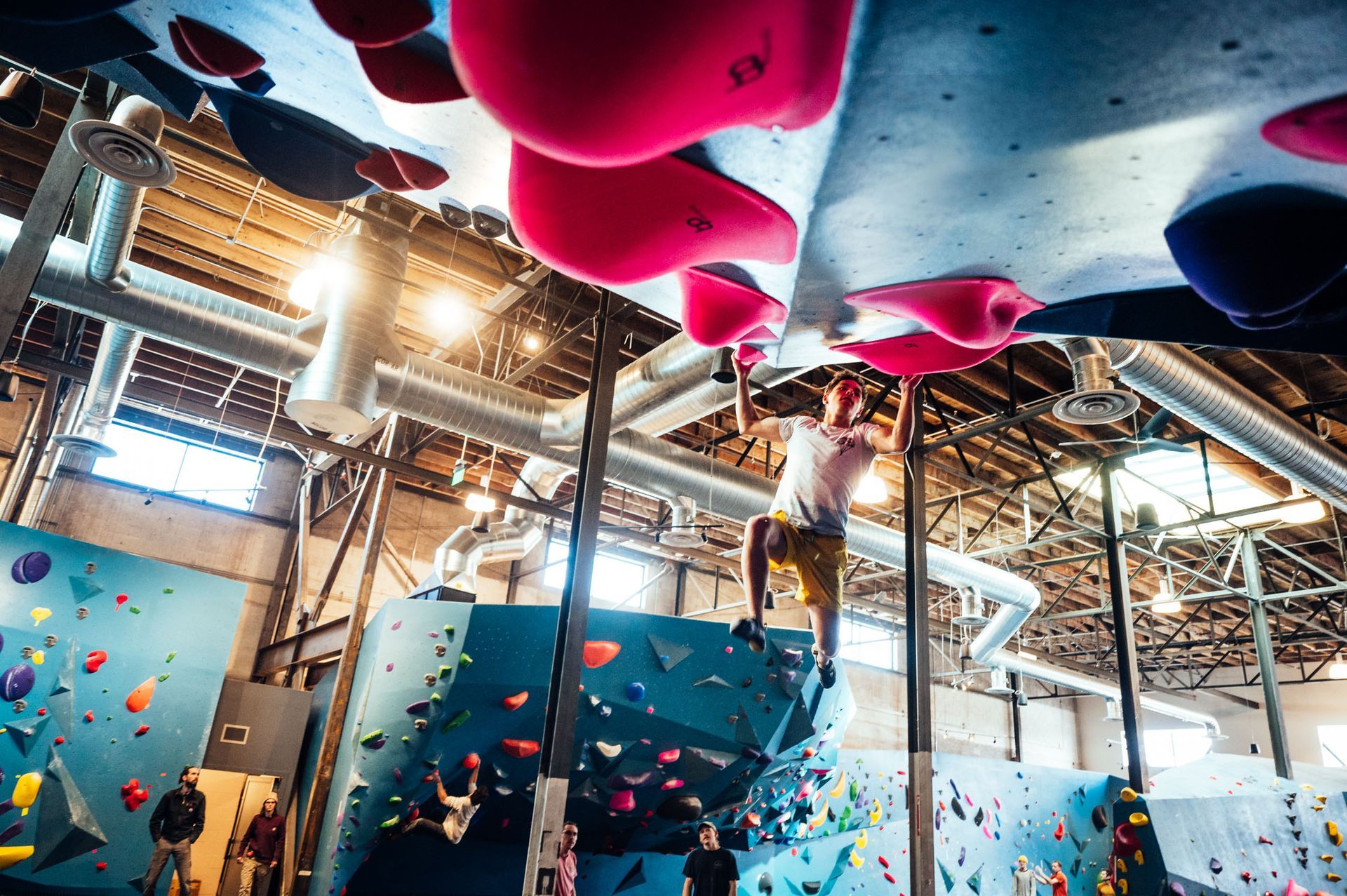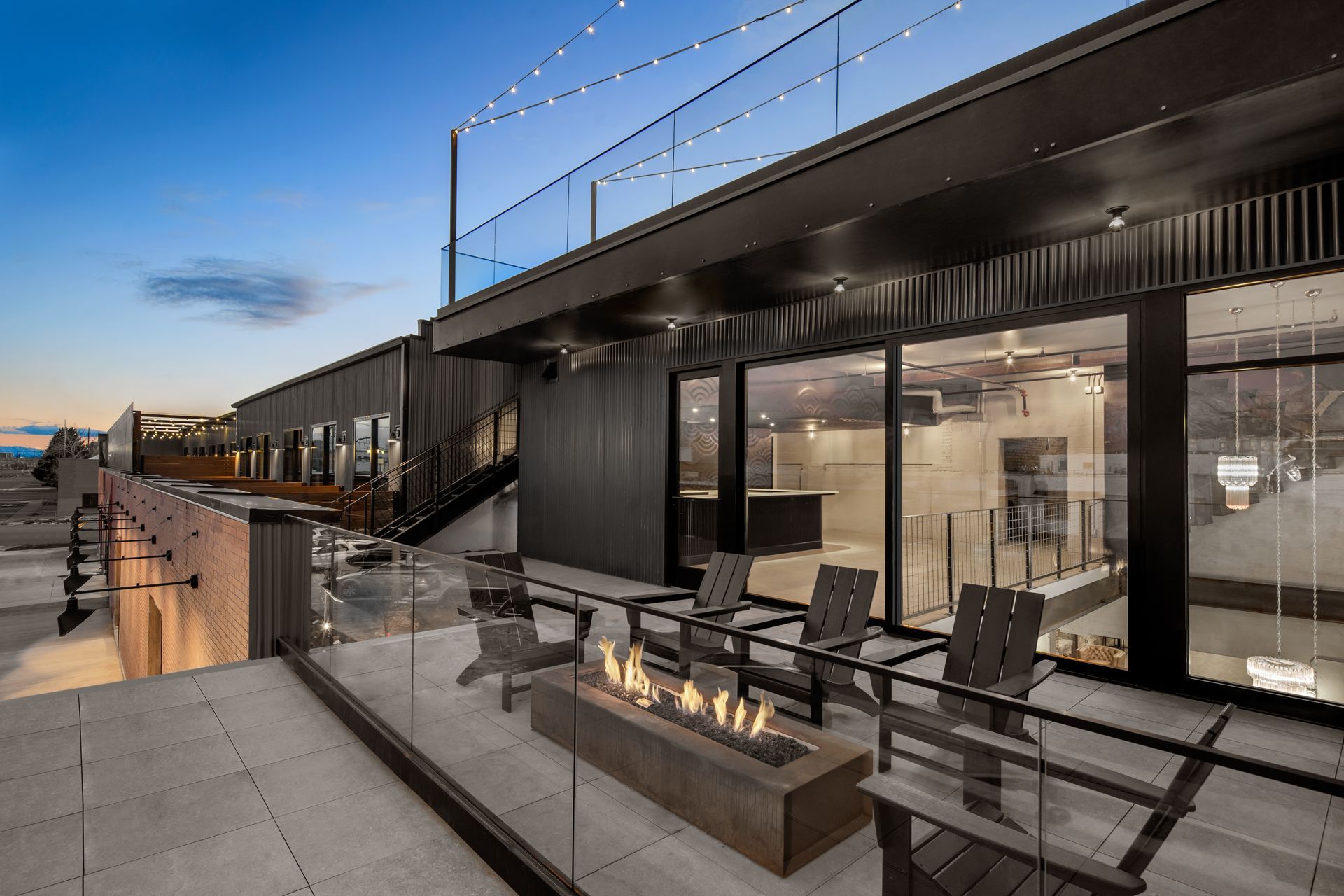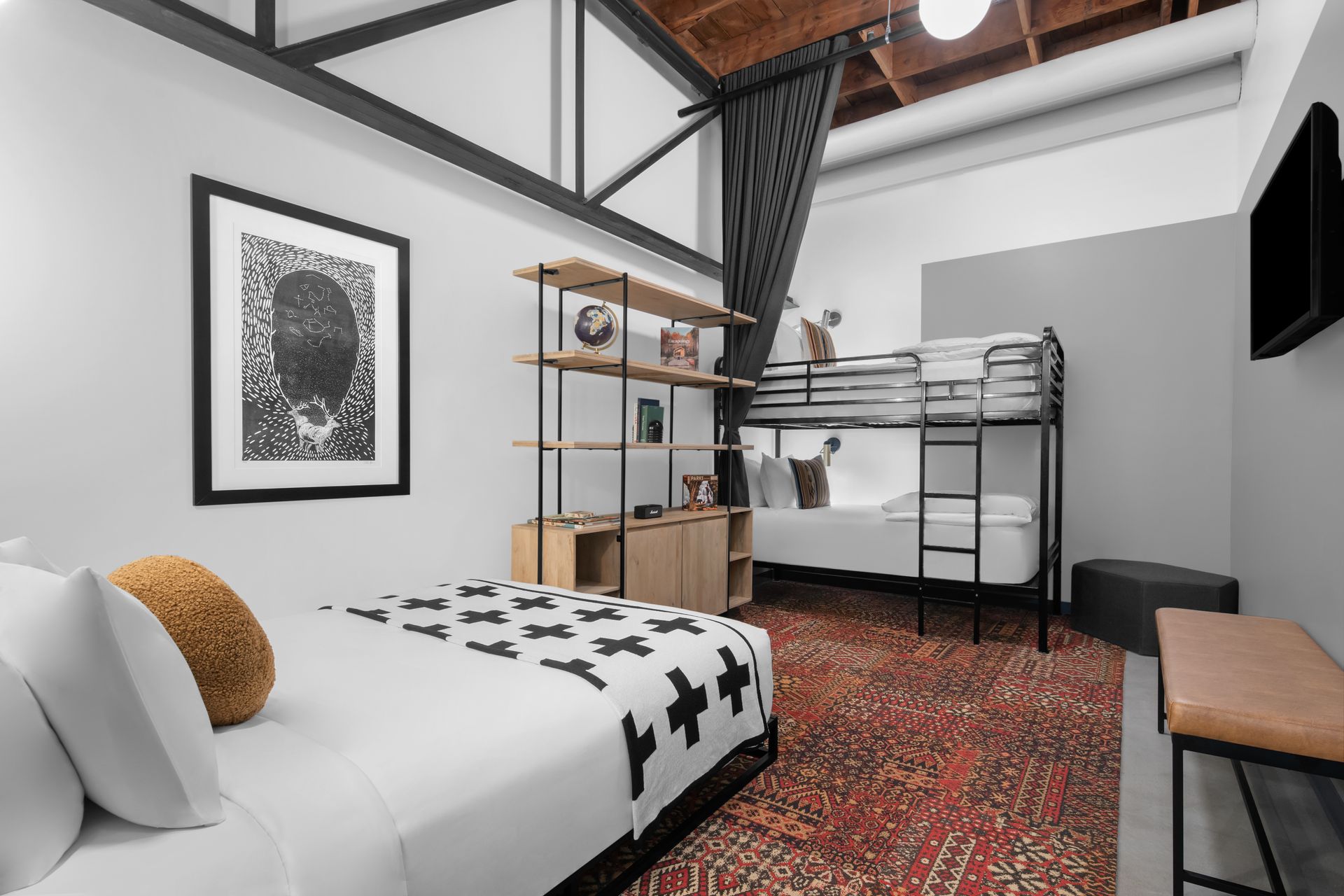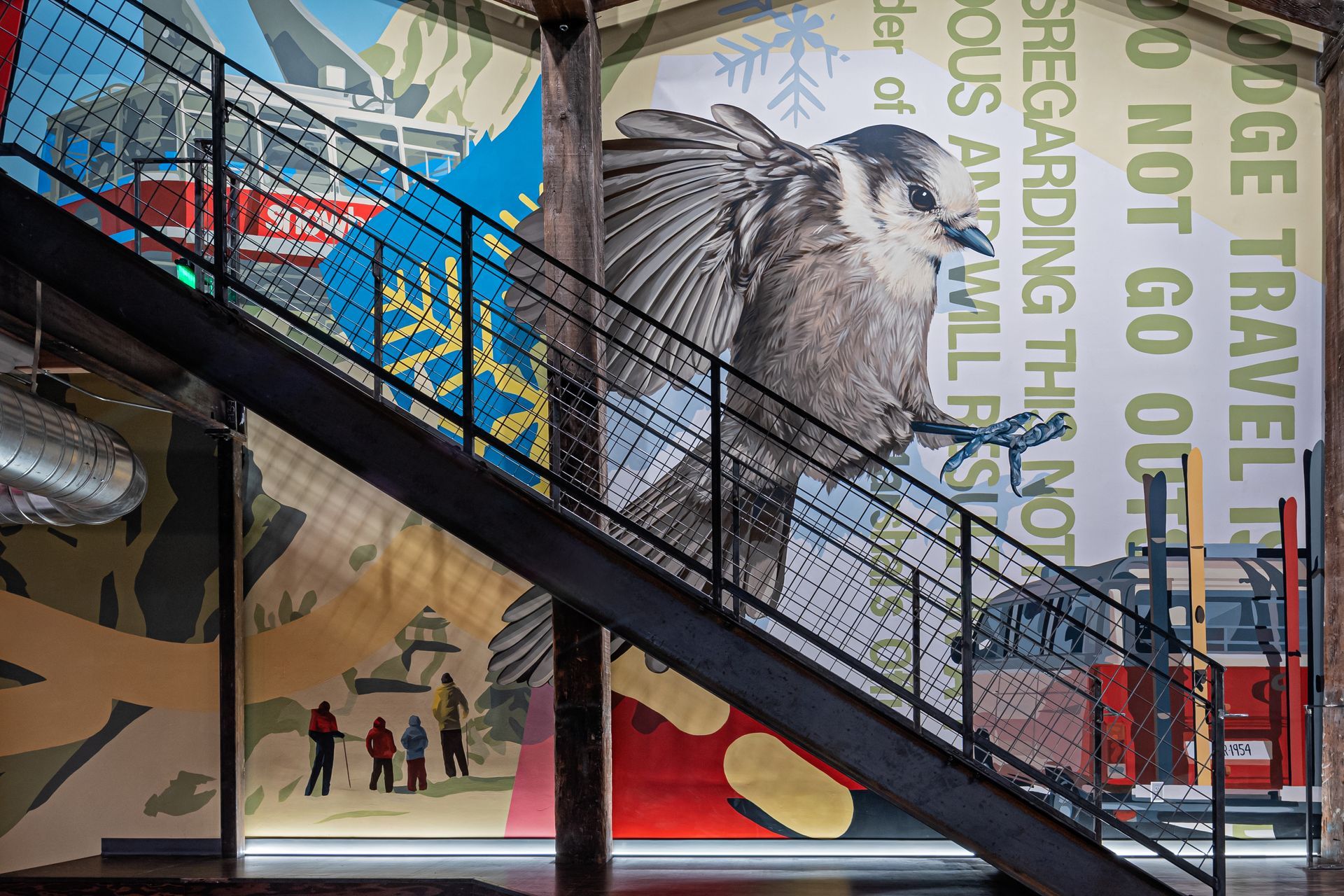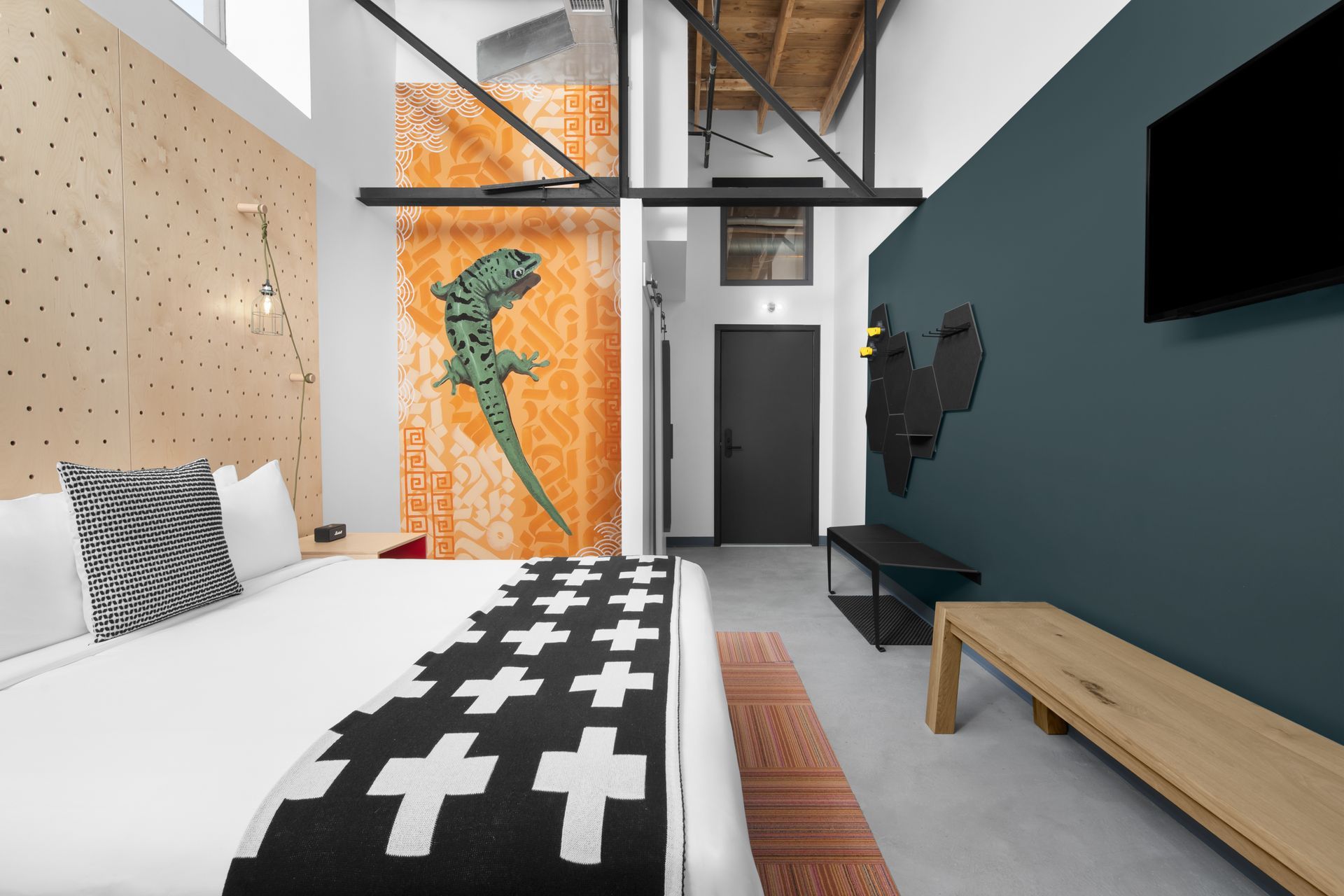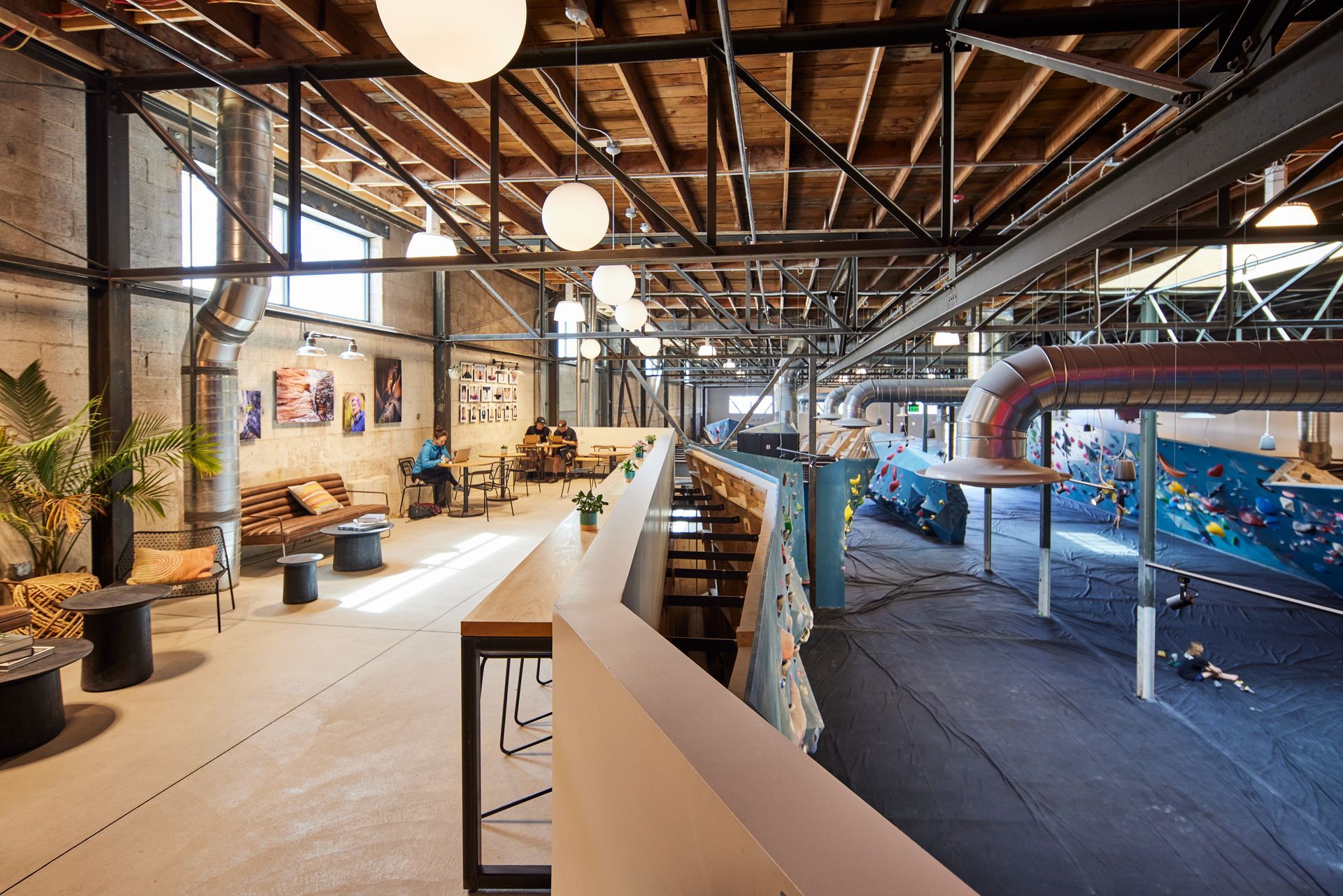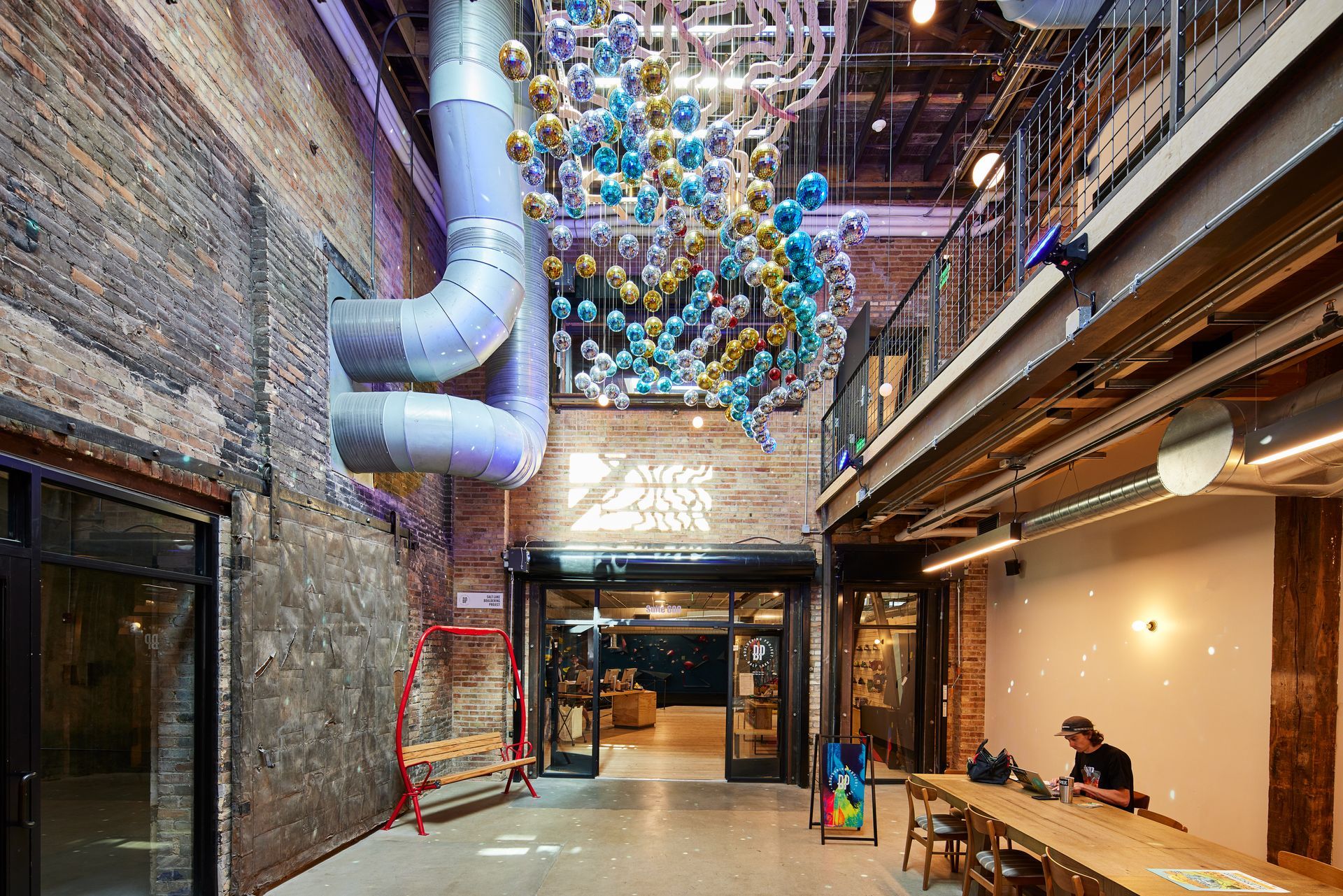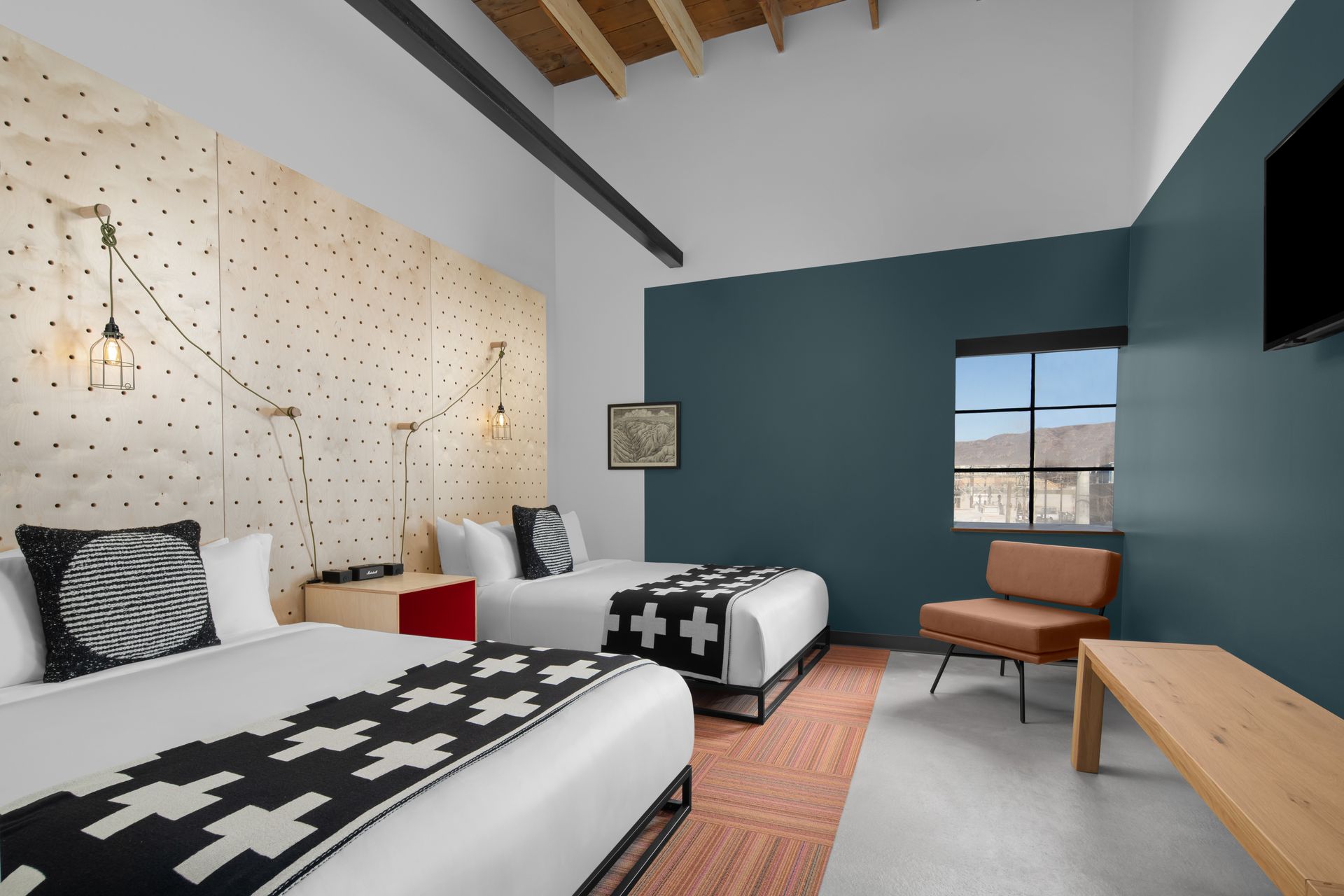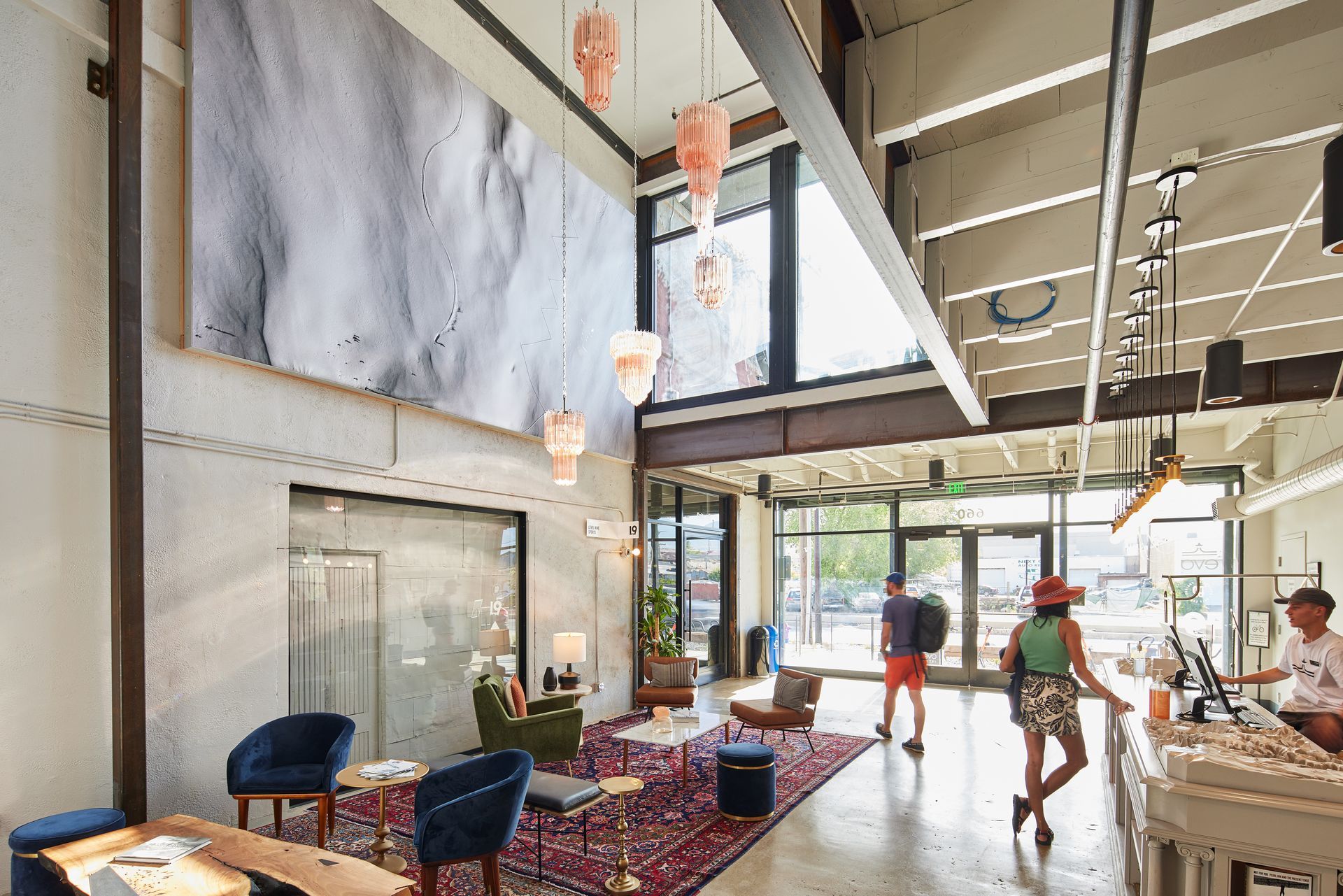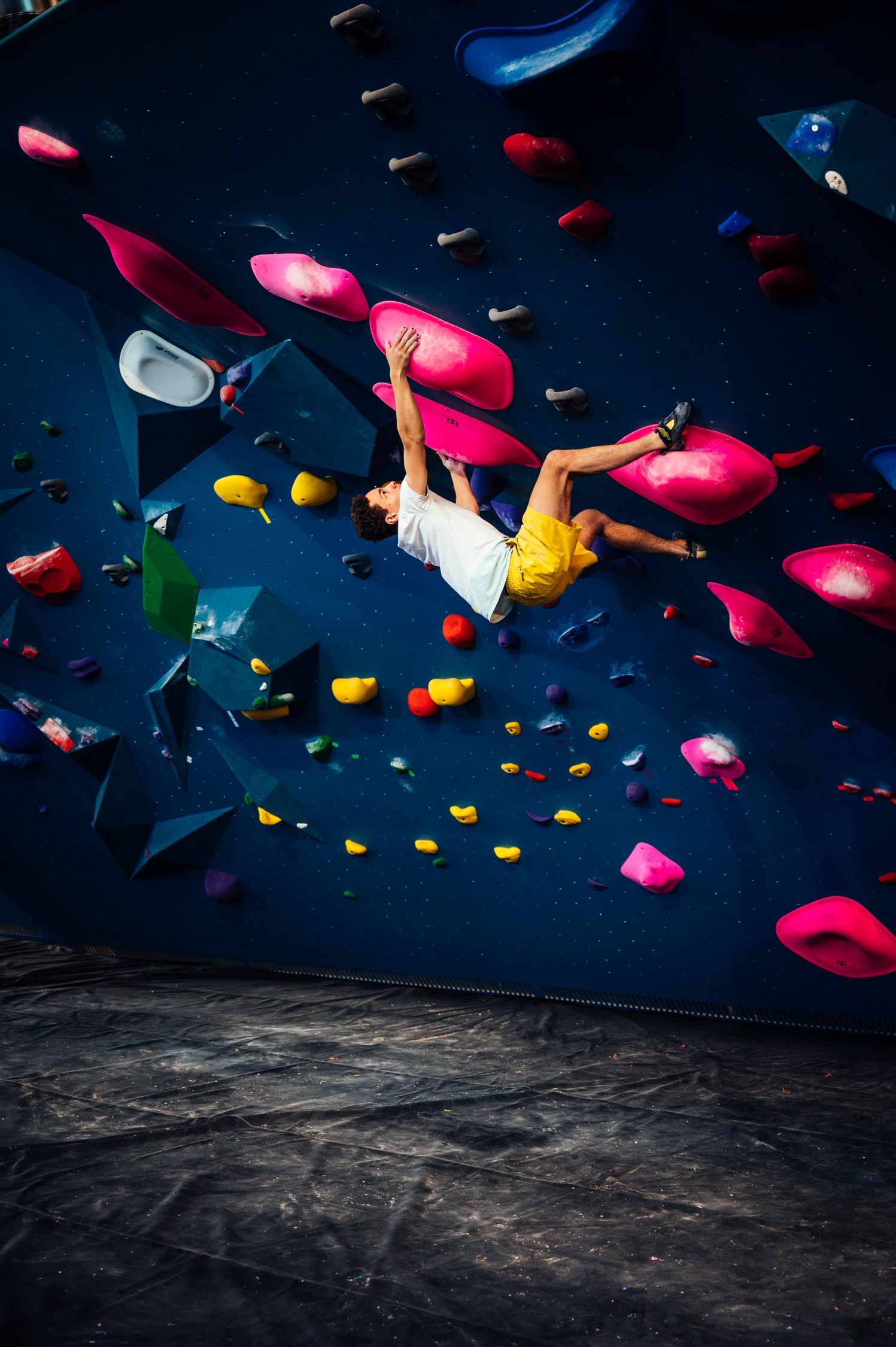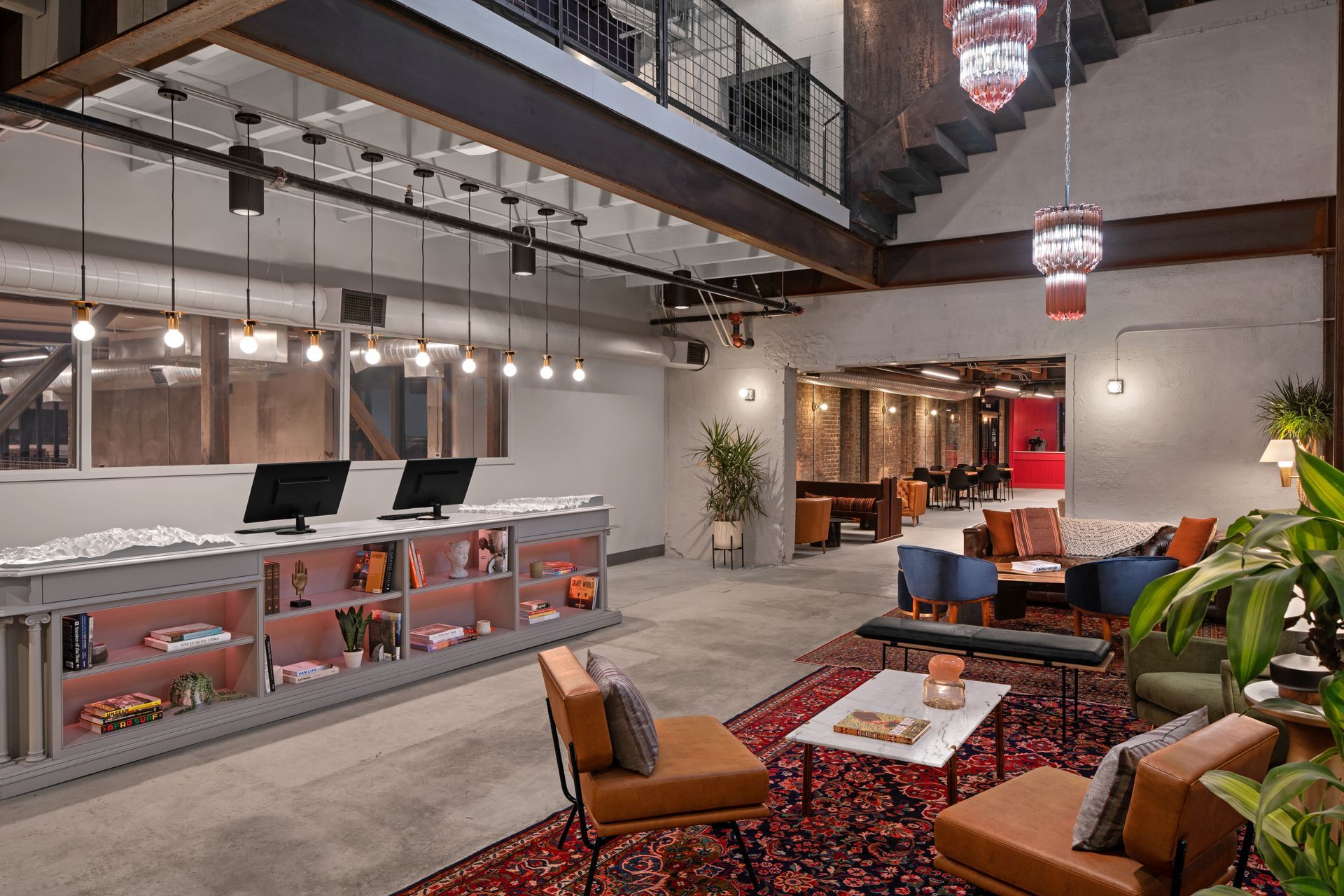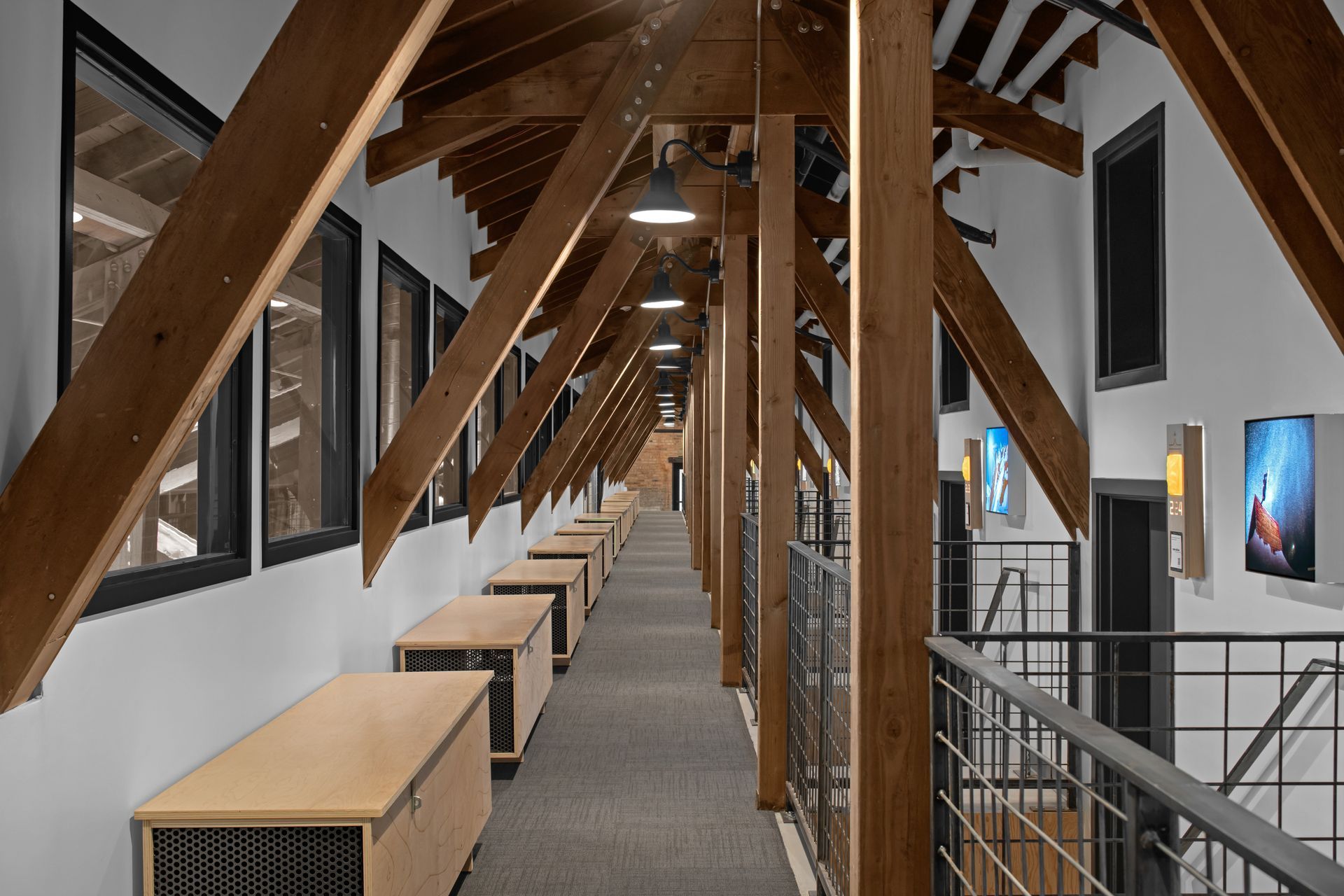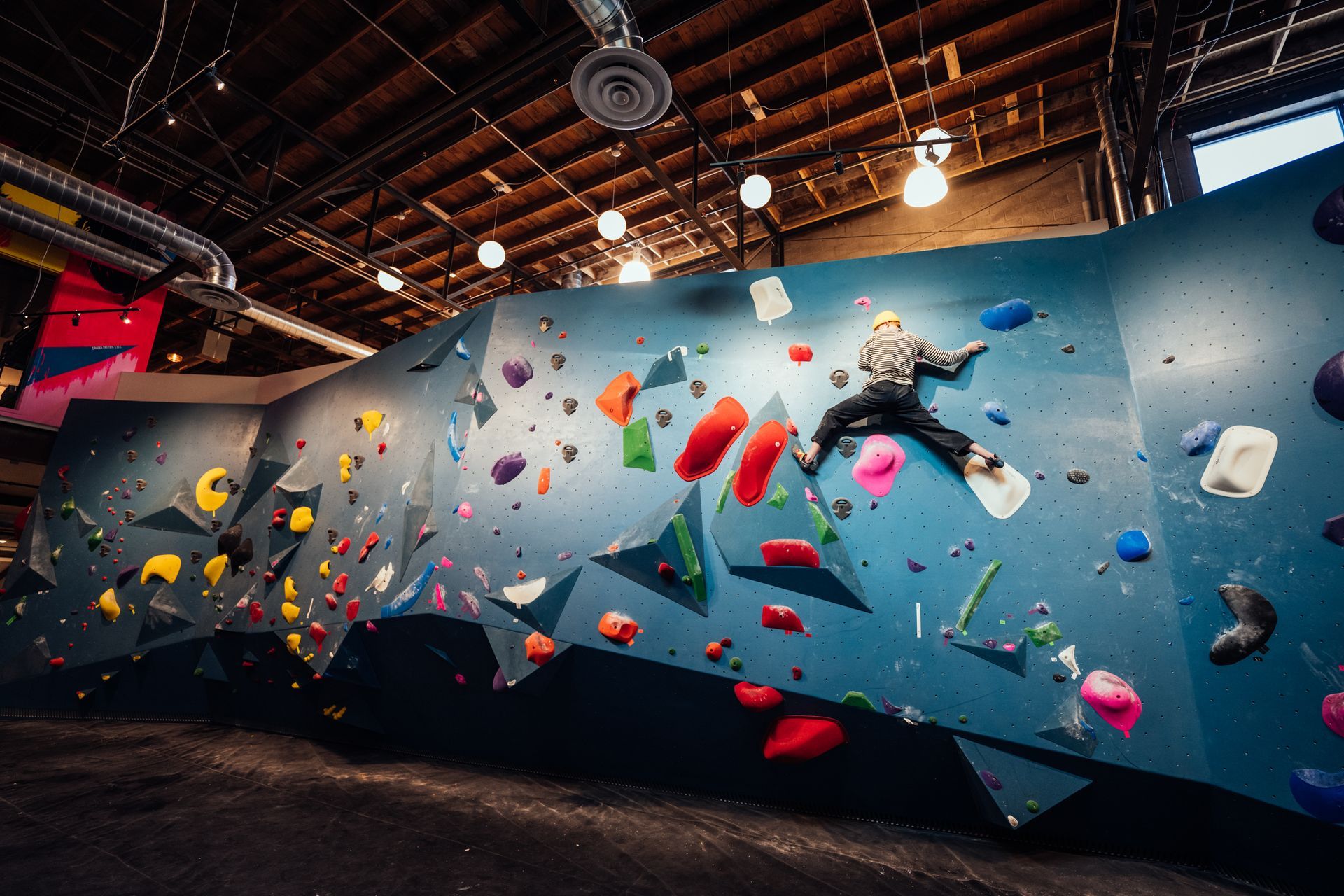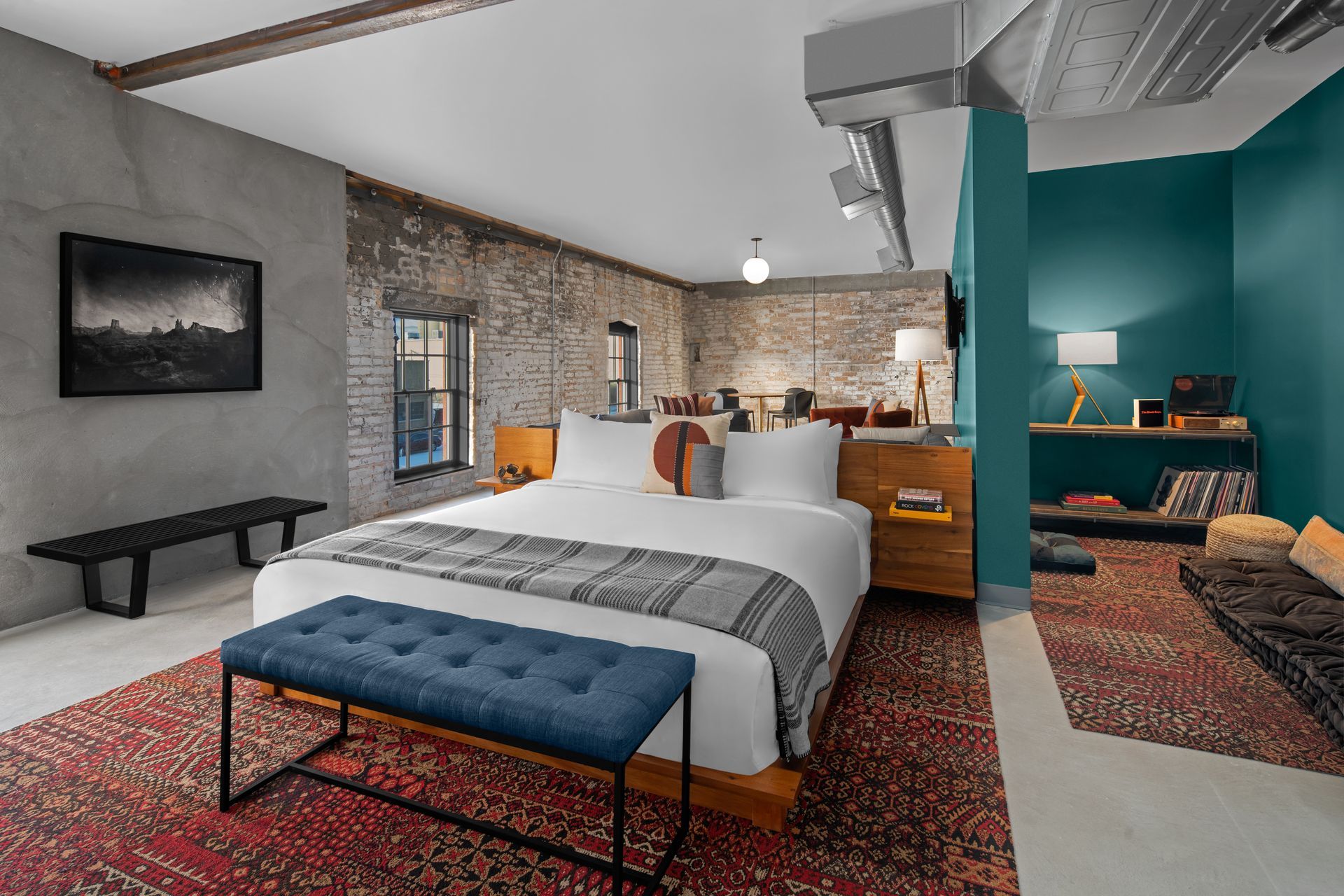Granary District’s new evo Campus is a stunning adaptive re-use that brings excitement to Salt Lake’s west side while engaging the local outdoor recreation community. By Emma Penrod
A mishmash of a hotel, bouldering gym, skate park, café, retail shops, and more may not seem like the most logical development choice by today’s standards, but for a 100-year-old warehouse with nearly as many additions as it now has tenants, it was, perhaps, the most authentic.
evo’s new Campus Salt Lake, which opened to the public formally in June, features an eclectic blend of tenants. These include the Salt Lake Bouldering Project’s 26,000-SF gym, homegrown outdoor retailer Level 9 Sports, and of course the evo Hotel, the first of its kind by the outdoor lifestyle brand founded by Bryce Phillips, who founded evo in 2001 as an e-commerce outdoor retail company. That unique blend of tenants reflected what the development team found when they first toured the Campus site in Salt Lake’s Granary District.
The original warehouse on the site was constructed in 1891, according to Arne Westbye, Project Superintendent for general contractor Kier Construction of Ogden. Additional warehouses were built through 1954, and over time, developers began to fill in between the separate buildings to combine them into a single space. In addition to a mix of materials ranging from plaster walls to steel beams, the property boasted historical amenities such as a buried former railway line beneath it, and specialized rooms for storing cotton in the basement.
Between that and its location near downtown Salt Lake, I-80, and Salt Lake City International Airport, the old warehouse had everything evo had been looking for, according to Tommy Trause, Head of New Locations and Hospitality for Seattle-based evo + evolution projects.
evo got its start as an online outfitter, distributing sporting goods from Phillips’ garage in Washington State, Trause said. But as the company expanded and began to offer more real-world, experience-based retail options, Salt Lake—a city with which it had little familiarity—kept showing up on the radar.
They had some connections in the area, Trause said, and one of those contacts recommended they look for a property in the Granary District. This eventually led them to what was then, at least on the outside, an unremarkable vacant warehouse.
“We do see the beauty in those old warehouses,” Trause said. “You walk into a building that is forgotten and somewhat left for dead, and you see this gorgeous brick and 100-year-old trusses—the bones and DNA of that building are spectacular.”
Working with old buildings always comes with surprises, but the vision evo laid out for its new campus was essentially what you see at the site today, according to Project Architect Aaron Day, a Senior Associate at Salt Lake-based Lloyd Architects. The key tenants were committed to the project from the beginning, giving it both a clear structure and needed financial stability, explains Newton Brieter, Creative Director for developer Lake Union Partners of Seattle.
“They created a story book of ‘This is what we want to do’—this is the experience we are going to be providing,” Day recalled.
The core element, Day said, is the great hall, a spine from which everything else could branch. From the main entryway, guests have access to the L9 and evo retail spaces, the hotel check in desk, a cafe, and—at the end of the hallway—the bouldering gym. And evo wanted to make it all happen while making as few changes to the property as possible.
“We wanted to leave exposed all of that character so you could see the building had seen 120 years of use,” said Breiter. “The new design elements were intended to contrast that, not replicate it.”
Fortunately, Day said, the warehouse property lent itself well to the objective. Although combined over the years, the warehouse is still clearly comprised of five separate buildings, each with its own style. So, the team took advantage of the site’s quirks. The Bouldering Project would go in the newest section, which featured block walls and steel trusses from the 1950s, while the retail space was assigned an older portion of the building with exposed brick and gabled wood trusses.
But the project would require making some changes to the property, Day said, because the original square footage was not large enough to accommodate the hotel evo hoped to build. Designers took advantage of the warehouse’s tall ceilings and added a second floor for the hotel rooms, raising the ceilings for just 13 of the rooms.
The addition, Day said, is concealed by a replica of a historic sign they noticed in pictures of the building from the 1920s. This had the added benefit of creating private outdoor patios for some of the hotel rooms.
Warren Lloyd, Founding Partner of Lloyd Architects, said the fact that the 47-room hotel occupies four separate fingers of the building—overlooking the bouldering gym and also tucked into the rafters and into the historic building’s façade—presented some unique challenges.
“We had to work creatively to interpret how the hotel rooms could fit into the roofline of the building and respect the standards, while we added not only hotel rooms, but the walkout decks,” said Lloyd. “It was a collaboration not only of evo and Bouldering Project, but the (Utah) State Historic Preservation Office to meet standards for historic rehabilitation.”
“It’s their first branded hotel,” Lloyd continued, “and it was really a bold, creative venture. Not many businesses can brand (their) own hotel, but they have integrated the evo brand, they have an outdoor community and have a network that makes them somewhat unique. They said ‘we’re going to start with outdoor enthusiasts’ […] (and) realized it’s beyond that. They have created an inviting environment where business and leisure travelers are drawn to the activities.”
Lloyd added his firm relishes working on historic projects, with the Granary Campus a particularly satisfying endeavor.
“For me personally and us as a firm, we love history, but we love adaptive reuse of structures to meet our current needs,” he said. “We are a modern architecture office but being able to work within historic environments allows us to think creatively.”
“When you look at the physical site itself, you have this view of the Wasatch Mountains, the canyons, and then downtown, and we wanted to make sure we preserved these sightlines and ground the project in a sense of place,” Trouse said.
Even if the design came together relatively smoothly, construction in a historic structure is never without it challenges, said Andrew Smith, Vice President of Operations at Kier Construction.
“The safety measures are much more extensive than normal when you’re cutting into a brick wall that’s crumbling as you do it—in order to ensure you have what you intended come down, and not what you didn’t intend,” Smith said.
While adding the second floor, Kier Project Manager Paul West said, one section butted up against an unreinforced brick wall built in the 1990s. In order to ensure the wall stayed put, he says, the team essentially built an “external skeleton” of steel to support the structure. Elsewhere, the team added 8-inch concrete facings to keep existing walls, especially the exterior walls, intact.
In addition to maintaining the building’s historic heritage, evo also wanted the campus to reflect the flavor of the local community. This took the form of hiring 62 local artists, through a collaboration with a Utah-based photographer, to create pieces for the hotel rooms and on-site art galleries.
“The Granary neighborhood has a rich history of street art and local artisans, so we hired a lot of people from that neighborhood,” Trause said. “We even hired a furniture maker who is two doors down from us.”
But beyond a one-time collaboration, Trause continued, evo aimed to create a space that would continue to invite in and engage with the local community for years to come. Making the “All Together Skate Park”—an onsite indoor/outdoor skate park—the building’s “front porch” was a conscious decision, he said.
“We have found, and strongly believe, that skate is one of the most tangible, accessible ways to invite people into the action sports industry,” Trause said. “It has a much lower cost barrier [and] a good history of inviting all humans.”
So far, this decision seems to be paying off and making the neighbors feel just as welcome in evo’s new campus as the international guests they hope to attract to their hotel. But the greatest award, he said, is watching the community come into the campus and make it their own.
“I think with the grand opening party and a few different events we have held so far, we
are seeing little kids running around, people who you wouldn’t see as specifically outdoor-focused,” Trause said. “I think that will eventually be our litmus test as far as, ‘Did we succeed?’ We are really proud and humbled with being able to walk away now that other people are taking control, operating the building, and making sure it does feel like home and welcome all these people.”
Granary Campus
Owner: Granary Campus, LLC
Owner’s Rep: Newton Breiter
Developer: Lake Union Partners
Design Team
Architect: Lloyd Architects
Civil: Johanson Engineering
Electrical & Mechanical: Royal Engineering
Structural: Calder Richards Consulting Engineers
Geotech: IGES
Landscape: Loft Six-Four
Interior Design/Furniture: Vida Design
Construction Team
General Contractor: Kier Construction Corp.
Plumbing: Robert W. Speirs Plumbing
HVAC: CFM Heating & Air
Electrical: Next Level Electric & Salmon Electric
Concrete: Black Rock Concrete
Steel Fabrication: Gos’s Welding
Glass/Curtain Wall: Spencer’s Glass & Construction
Masonry: RJ Masonry
Drywall/Acoustics: Wallboard Specialties
Painting: Keith Pulham Painting
Tile/Stone: Popp Enterprises
Carpentry: Ron J. Peterson Construction, Inc. & Bedier Construction
Flooring: Popp Enterprises
Roofing: Weather Tech Fabricators
Excavation: TEC Excavation
Demolition: TEC Excavation (site demo); A-Core Concrete Cutting, (interior demo)
Landscaping: Landscape Specialties; Mountain West Paver Specialists


















